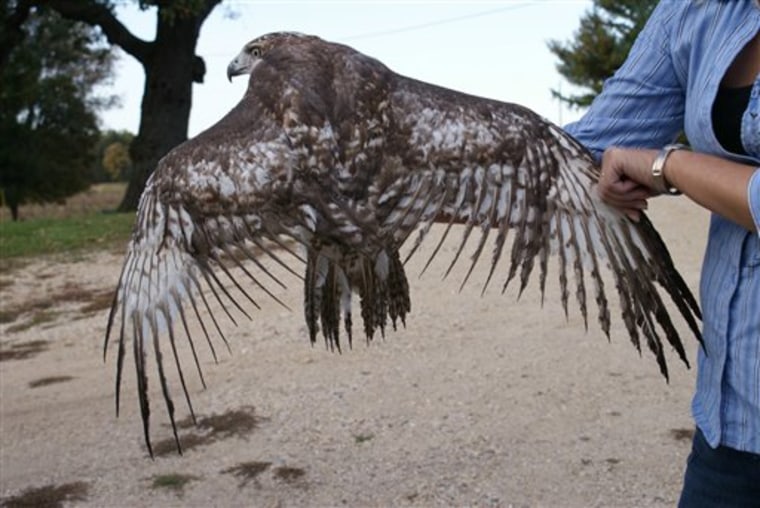A towering landfill smokestack offers an irresistible perch for raptors to watch for rodents scavenging in the treeless landscape below. But when flames fed by landfill gas rush upward, the birds are being scorched or burned alive.
At the urging of wildlife rehabilitators, the solid-waste industry is starting to investigate where birds may be at risk and ways to protect them — such as welding deterrent spikes atop smokestacks and providing alternative perches.
It's unclear how widespread the problem is, but suffering or dead birds have been reported in recent years in New York, Oklahoma, Wisconsin, Pennsylvania and Illinois.
"I heard about the horrific injuries these birds were suffering throughout the United States, and I wanted to do something about it," said Stella Miller, president of the Huntington Audubon Society on Long Island, who launched a Save Our Raptors campaign to raise awareness and seek solutions.
Trying to make flares safe
The U.S. Fish and Wildlife Service, which only recently became aware of the problem, is working to alert landfill and utility associations and advise them to explore options to make flares safe.
"This issue was brought to our attention recently and in many cases, when landfill operators were notified that there were injured birds because of the flare, the landowners were not aware of the problem," said Alicia Frances King, an agency spokeswoman.
Gary Siftar was mystified when he started seeing red-tailed hawks with scorched feathers at his wildlife clinic in Broken Arrow, Oklahoma. Fellow rehabilitators at a national conference told him the likely culprit was his local landfill.
Siftar's Oklahoma Raptor Center is about five miles (eight kilometers) from a landfill where a smokestack 60 feet (18 meters) tall and 18 feet (5.4 meters) across burns off methane produced by buried garbage. He concluded that hawks were being singed on the stack.
He wrote a paper on the issue for the National Wildlife Rehabilitation Association last fall and got e-mails from rehabilitators across the country who had treated hawks and owls with singed wings and tails, melted beaks, scorched talons and other burns from landfill gas flares.
Other raptor hazards
It's unknown how big the problem is compared to other raptor hazards. Rehabilitators receive hawks that have been hit by trucks while dining on roadkill, owls tangled in soccer nets, and raptors poisoned by lead shot or pesticides, shot illegally, or snagged on barbed-wire fences.
At their spring conference in Albany, the New York State Association for Solid Waste Management and the Federation of New York Solid Waste Associations passed resolutions to join Audubon's Save the Raptors campaign.
"We get bashed all the time; we're kind of 'down in the dumps,' if you will," said Meg Morris, who chairs the federation. "We fell in love with the idea of doing something this positive. If New York can be a leader in this, it would be great."
Raptors are protected by law
The Solid Waste Association of North America plans to discuss the issue during its annual conference of landfill managers in Georgia next month, said Jeremy O'Brien, director of applied research for SWANA.
Landfill operators may be motivated by more than altruism. Since raptors are protected under the federal Migratory Bird Treaty Act, landfill operators could be held liable if a hawk was harmed by their equipment, King said. A violation of the act carries a sentence of up to six months in jail and a fine of up to $15,000 per bird.
Of the 63 permitted landfills in New York state, 32 have intermittent flares, according to the state Department of Environmental Conservation. Intermittent, automatically igniting flares are believed to be the most problematic. Birds are less likely to land on continuously burning flares, and landfill workers who switch flares on manually can check first for perchers.
Other states dealing with problem
Rehabilitators in several other states have also launched campaigns to confront the problem.
Dianne Moller, who runs the Hoo's Woods rehabilitation center in Milton, Wisconsin, has received red-tailed hawks and great horned owls found at the landfill in nearby Janesville with singed feathers and feet and blistered eyes. It takes nearly a year to rehabilitate these birds because they have to molt, grow new feathers and then rebuild their strength in a flight cage before release, she said.
When Moller brought a scorched hawk to landfill manager John Whitcomb last fall, he had an engineer come up with a way to weld a crown of steel spikes on the rim of the methane flare pipe to discourage hawks from perching. The landfill also installed a utility pole taller than the burner in hopes that raptors would perch there instead.
"It's hard to say how many birds are injured this way," Moller said. For every one brought to rehabilitators, many more may starve or be eaten by predators because they can't fly with feathers scorched to their quills, she said.
Problem is with intermittent flares
Joe Giebelhaus, manager of Albany's municipal landfill, said the problem appears to be with intermittent flares that take perching hawks by surprise. The Albany landfill has a plant that collects methane to generate energy, and has a flare to deal with gas that exceeds the plant's capacity.
"We don't have an issue with hawks," Giebelhaus said. "Our flare runs continuously, and there are other higher places for them to perch."
Siftar hopes that by getting solid waste management people to work on it, a solution will be devised. He notes that the electric power industry has made great strides in coming up with designs that reduce the incidence of birds being electrocuted when they sit on power lines or poles.
"Eventually, as more landfills reclaim the methane for energy instead of burning it off, this problem may decrease," Siftar said. "But even then, they'll have some kind of flare."
